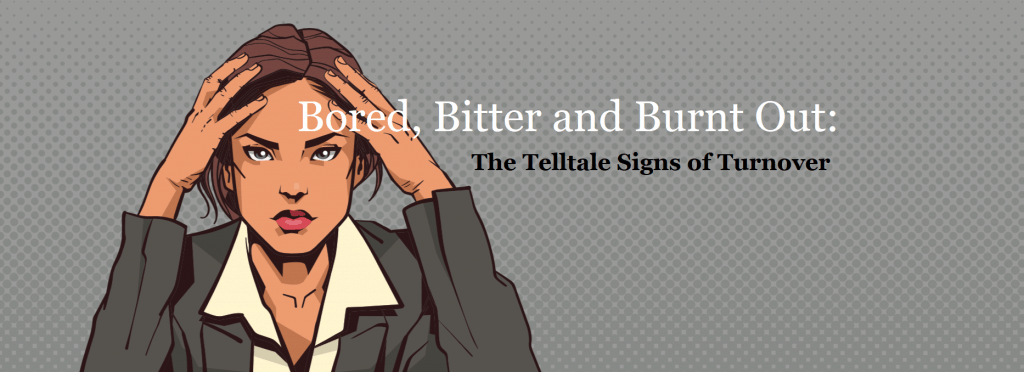Summary: Nothing makes an employee want to leave a company faster than feeling bored, bitter or burnt out. We explore how to identify the telltale symptoms. We give advice on “digging your heels in” and learning to cope with a difficult job. We conclude with elegant exit strategies for career professionals ready to risk it all and look for other opportunities.
“I find myself being late to work on a consistent basis.”
“I feel sad when I reach the parking lot in the morning.”
“I feel depleted at the end of the workweek & need to use my weekends to rest and recuperate.”
If you’ve ever said these things – then you need to read this article. Burnout is a mental health issue that merits to be addressed.
What is Burnout?
Burnout can be defined as “an emotional and physical exhaustion as a result of job related stress.”
Symptoms of Burnout: A Checklist
- Feeling physically drained. Feeling depleted by the end of Friday. Most of your weekends go towards rest, recovery, and recuperation.
- Feeling mentally fatigued. Not having the headspace that you normally have outside of work. Not feeling like you can dedicate full attention to other people or personal projects. Attention span on the fritz. Short term memory begins to wane.
- Emotional strain. Unable to be emotionally available for others or handle the emotional toll that family, friends, and social situations ask for. (This is common in healthcare workers).
Others notice. Other people notice that you’re looking tired, and may tell you so. Friends or acquaintances you haven’t seen in a few months may notice the manifestations of stress in your appearance, way of speaking and body language.
People that are burned out report feeling:
- Stuck or trapped
- Exhausted or overwhelmed
- Unmotivated
- Too Serious
Symptoms:
- You repeatedly complain
- Dread going to work; chronically late
- Tired no matter how much you sleep
- Stuck; trapped
Sweden and the Netherlands are two countries that classify burnout as a medical condition. An estimated 13% of their population suffers from burnout. The World Health Organization recognizes the importance of diagnosing it early and introducing preventive measures.
How to Measure Burnout
The Maslach Burnout Inventory (MBI) is recognized as the leading measure of burnout. It is survey you can take in 10 minutes to see if you’re experiencing burnout. We found a limited (free) version of it on Mind Tools and the full (paid) manuals, licenses, and tests on Mind Garden.
Human Resource practitioners on a budget can print out a copy of the MBI (free pdf) and tailor the questions to their respective industry. We urge HR directors to step up and address the health and wellbeing of their staff members.

The Science of Boredom
“Someone who is bored wants to have something to do and wants to feel engaged – but isn’t. Boredom is the aversive experience of wanting, but being unable, to engage in satisfying activity.” -John D. Eastwood, Department of Psychology, York University
Source: academic study: The Unengaged Mind, 2012
Boredom at work is stagnation of ideas – and profits. When we lose that spark to continually improve ourselves, we are no longer connected to the higher purpose.
A Higher Purpose
The higher purpose made us want to join the job in the first place. Whether that was helping the poor or showing people how they can live healthier lives we joined for a reason. When we become bored, burnt out and bitter we lose that joy for life so critical to creativity and applied effort.
Besides money, healthcare, and vacations, our primary need at work is to feel valued for our work. There is an enormous value in the simplest kinds of genuine appreciation and respect. A simple “thank you” goes a long way.
Never Enough
Yet how many companies have permanently replaced the carrot with the stick?

How many employees think back nostalgically to fonder days, when the company’s mission wasn’t all about profit? How many managers only focus on what was done wrong, and how many directors are hypocrites, preaching one thing, but doing another? Too many.
See if this story doesn’t describe your company:
| How the President Kicked the Dog
The president and CEO meet in the boardroom with the stockholders. They are not happy; the company could be making more money. So they raise the production quota on the executives. The executives, now under pressure, call in the managers. The managers, pressed with even more demands, yell at the employees. The employees, feeling the hurt, go home and unload it on their spouse. The spouse, already stretched so thin, snaps at their child who was misbehaving. The child, having no one else to delegate the pain to, kicks the dog. |
From this story, we learn that pain travels downstream. When those at the top feel choked, those under them will feel it too. In the mad scramble for “more, more, more” we have lost sight of the one metric we must prize above all: low turnover.
Turnover
Keeping Turnover Low: Why Sustainability > Growth
“Sustainability is more important than growth” – Kevin O Leary, businessman & Shark Tank television personality

Kevin O Leary shared his recipe for success in a live talk on February 2019. In a nutshell, Mr. Wonderful said: Successful companies care about retention. Slow growth and survivability should take precedence over high growth numbers and immediate ROI. Lower your targets and set achievable goals, so that your sales and marketing teams can hit them 90% of the time. Keep that momentum and snowball rolling, and you will see engagement go up; no one will want to leave.
To illustrate, O Leary gave two examples of companies.
The first is a “macho” company with aggressive sales goals and a culture of hard sales tactics. The second is a more traditionally “feminine” company with (still ambitious), but far less startling sales goals. In his research of thousands of firms, O Leary found that:
The first company was able to achieve 30% year over year growth compared to the second company’s 17%. However, he called specific attention to the percentage of the goals and targets that were hit, and labeled these as a marker for company prosperity. On the surface it may look like you would want to be like company number one, but the unachievable goals unwittingly set a culture of favoritism, competition, office politics, and toxicity – a company rife with turnover. Company number two was less profitable year over year, but they survived and stuck around. |
In the second company, people were continually encouraged and kept motivated because the sales goals were achievable, and the carrot was always within reach.

The key lesson: Maintain cultures that have less employee turnover. Don’t create “out-out-of-the-ballpark, pie in the sky type goals,” or else people will leave. Lastly, motivate employees with carrots, not sticks.
Best In Class Companies Create Sustainably Engaged Employees

“When you don’t feel valued you can’t produce value.“ -Tony Schwartz, American journalist, writer, researcher
In a New York Times article, Schwartz goes on to say that “high engagement as it has been traditionally defined is no longer sufficient to fuel the highest levels of performance. The companies with the highest profit margins want sustainably engaged employees.”
Sustainably engaged employees are created when leaders take steps to build trust, demonstrate sincere interest in employee well-being, and create systems wherein workers can manage stress levels with a reasonable balance between work and personal life.
Quitting Time?

Your Options Should You Choose to Stay (or Leave)
Your task now is to figure out if it’s worth it to keep going on. You have a few options at your disposal if you’re at your wit’s end with your current employer.
You can Move up, Move out, or Move on.
- Moving up. Ask a trusted confidant if you can move up vertically or laterally within the organization. Can you take a certificate or course that will open up a management position for you? Can you rotate jobs? Work under a different manager? Scale back current work responsibilities by showing how your job has changed in size and scope since you were initially hired.
- Moving out. Move out by relocation, vacation, or a remote work arrangement. A relocation can get you working in another location, team, or division. Taking a vacation will enable you to to cool your head, focus on your vision, decompress, and come back with answers. Moving out can also refer to scaling down & reducing workload and hours, such as turning a full-time job into a part-time job. Finally, ask if working remotely is an option. Create room for yourself to gain some headspace and clarity.
- Move on. When digging your heels in, grunting it, and bearing it is simply unfeasible, it may be time to update that resume and seek other opportunities. Get the word out to recruiters. Start alerting your network. Do Not tell your employer until your next opportunity is secure.
For additional advice contact Tammy Klein to schedule a one-on-one consultation.
A Graceful Exit
Tips from Tammy on Exiting an Organization Elegantly
- First, make sure you have the details with your new employer worked out.
- Think about your transition of your current role.
- Write a resignation letter showing appreciation for your role and what the company did for you.
- Make sure you have a face to face (in person if possible or facetime) with who you directly report to. Don’t have them hear about it through the grapevine.
- Give adequate notice.
- Make sure you leave as a friend of the organization. You never know how paths may cross again and when you may need a reference, referral or future colleague connection.
Career Coaching for Professionals
Hire Klein HR Solutions to gain greater career confidence, insight, and encouragement. Behind the scenes Tammy Klein researches the market, makes edits to your resume, and calls hiring managers within her network – to get you the job you deserve.
Tammy’s methodology involves exploring your current career situation while identifying your differentiating factors and the value-propositions that make you unique in the marketplace.
Some of the services we provide are:
- Career Coaching
- Resume Revisions
- Long-Term Career Planning
- Job and Internship Search
- Identifying Career Paths
- Resume and Cover Letters
- Marketing Yourself
- Interview Prep
- Offer Negotiation
- Closing the Deal
Read more about Klein HR’s Career Coaching services.

If you’re “seeing the writing on the wall,” hire Tammy today for help on your career path.
| “I worked for Tammy for seven years and consider myself fortunate to have called her a boss, colleague and mentor. She is a senior, results-driven HR leader whose ideas motivate employees toward success and growth. She is passionate about building strong relationships and thinks outside the box to ensure her clients have a positive and meaningful experience.
Her proactive and competitive nature, along with her drive for excellence in everything she does, ensures those that work with her are always moving forward in the right direction. She may be small, but she is MIGHTY! Ask anyone that has had the pleasure of working with Tammy – she is held in high-esteem for both quality and results.” Laurie Vaughn, SPHR Human Resources Director RSM US LLP |
Conclusion
Turnover remains one of the most important metrics of company success. Nothing makes an employee want to leave a company faster than feeling bored, bitter or burnt out.
Burnout is a serious mental health issue. Left unchecked and unaddressed, it can wreak on individual health, and organizational stability.
We hope these tips help you make the most of the situation you’re facing. Share this article with someone who needs it.

